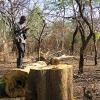Andy and the Sugar Factory
Flamingo Land’s Director of Conservation Science visits a sugar factory with the aim of protecting a threatened forest.
This rather different expedition was never going to reveal new species, but the Kilombero Sugar Company may hold the key to the survival of a forest and many rare species living there. The sugar company are the owners of a large part of the threatened Magombera forest, where the Udzungwa Forest Project (UFP) is carrying out it’s work on forest conservation. As part of efforts to save Magombera from destruction, Dr. Andy Marshall spent two days with the sugar company staff, exchanging ideas and learning about sugar.
The sugar expedition began with a discussion of options for the conservation of Magombera forest with General Manager Don Carter-Brown. The forest currently remains officially unprotected, much to the frustration of both UFP and the sugar company who are actively campaigning for government protection. There are many ways to protect a forest, varying from full protection as a nature reserve, down to villagebased management that allows local people to make conservation decisions. Local people are of huge importance for the success of conservation.
Conserving forest is of huge importance for farmers. Forests are extremely important for many kinds of agriculture, including sugar, which grows best in warm, wet areas with fertile soils. Because forests absorb rain water like a sponge, they release water slowly throughout the year. When forests are cut down, the water instead runs off very quickly, leading to soil erosion, infertile soils, and in the worst cases drought and famine like those currently occurring in east and north-east Africa.
Magombera forest also has huge importance for its wildlife. The forest is home to the recently discovered Magombera chameleon, the endangered Udzungwa red colobus monkey, and has a very high density of threatened tree species.
The future of Magombera forest depends on the speed with which the Tanzanian government acts to protect the area. Currently local people are confused at the “in limbo” status of the forest. Meanwhile the forest is threatened daily from pole-cutting, charcoal production and logging for timber, and is unlikely to survive much longer without official intervention.


